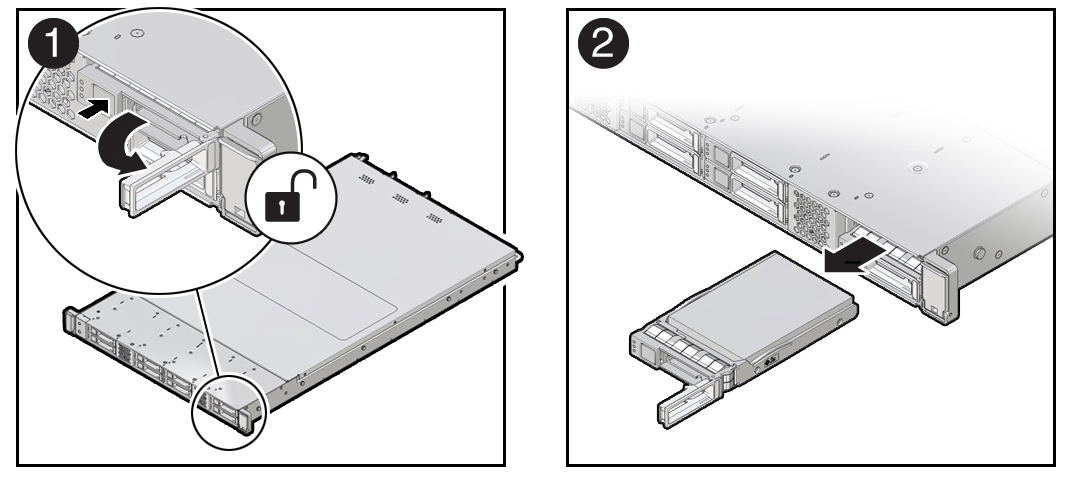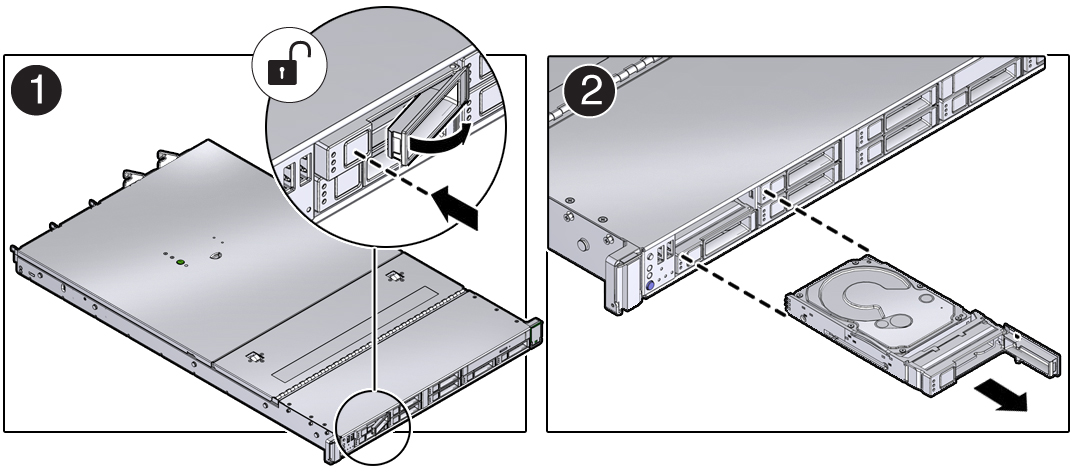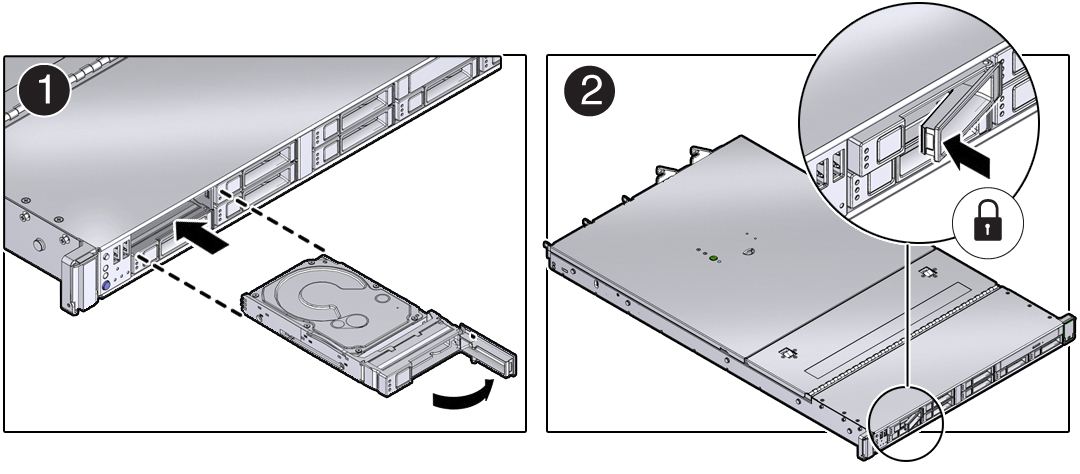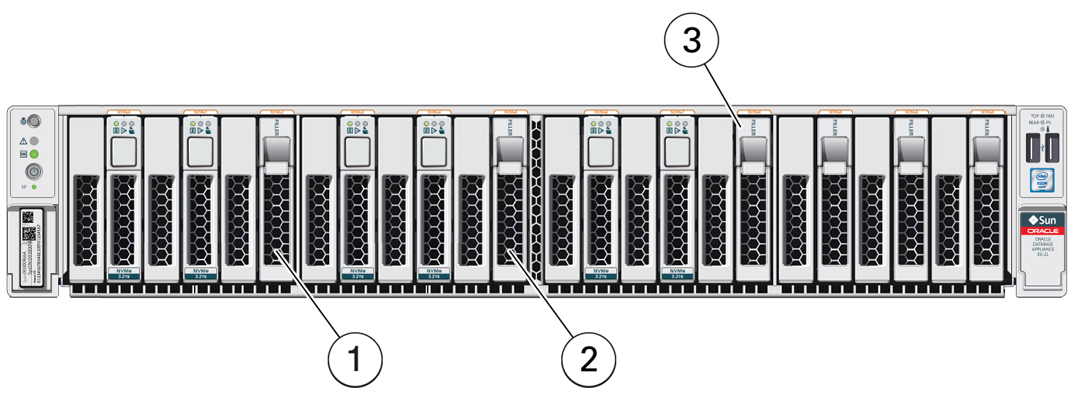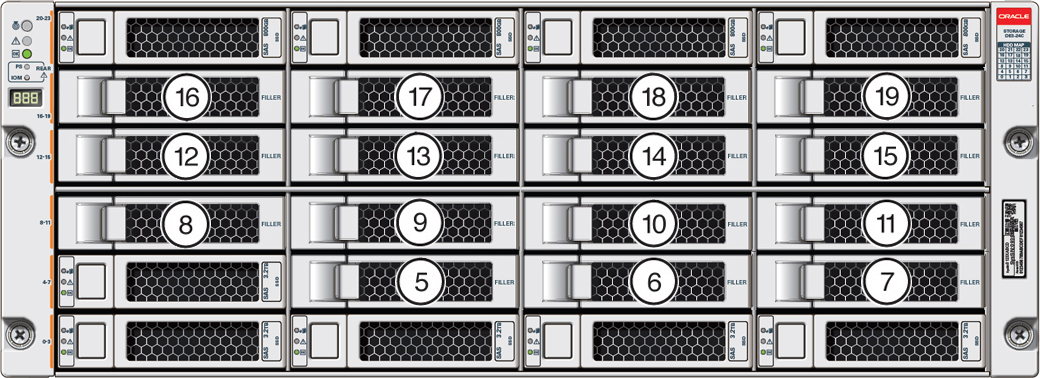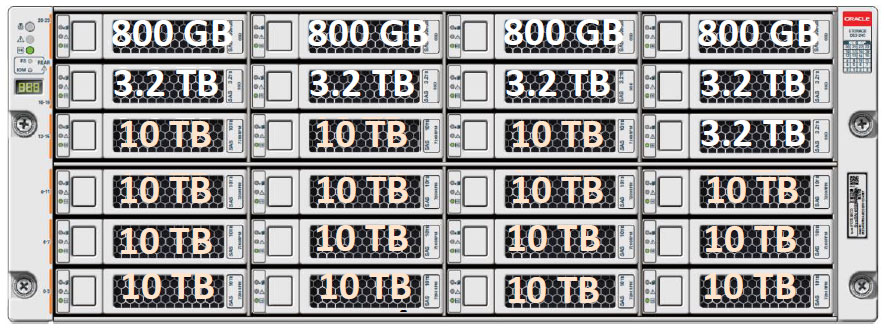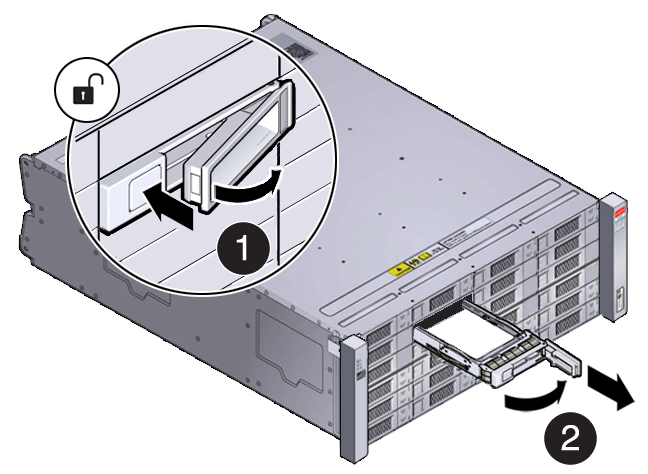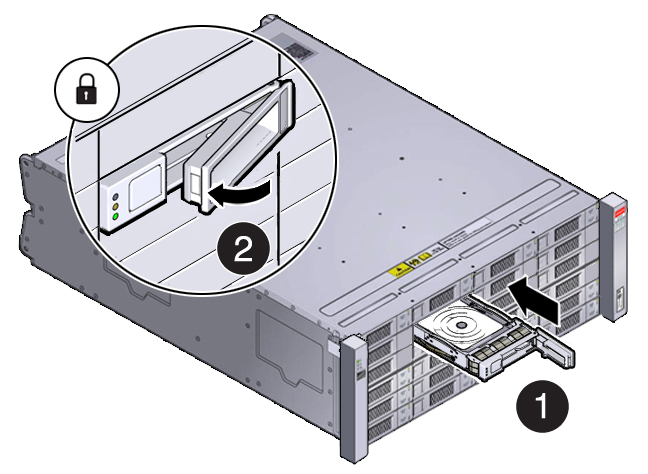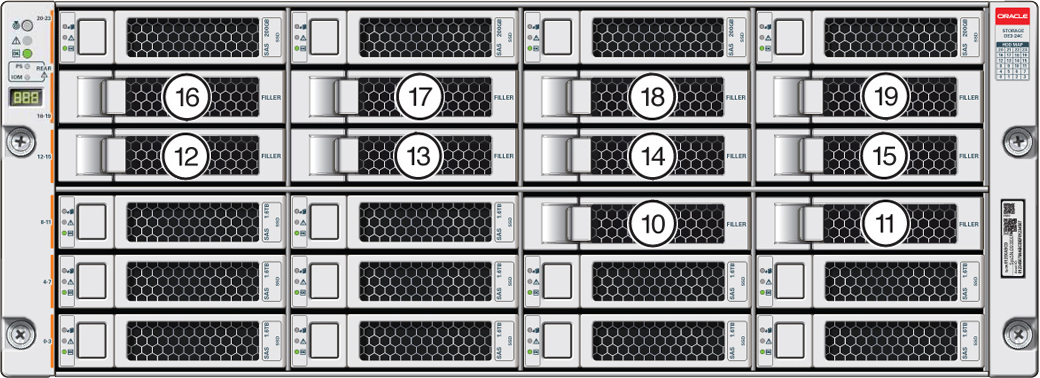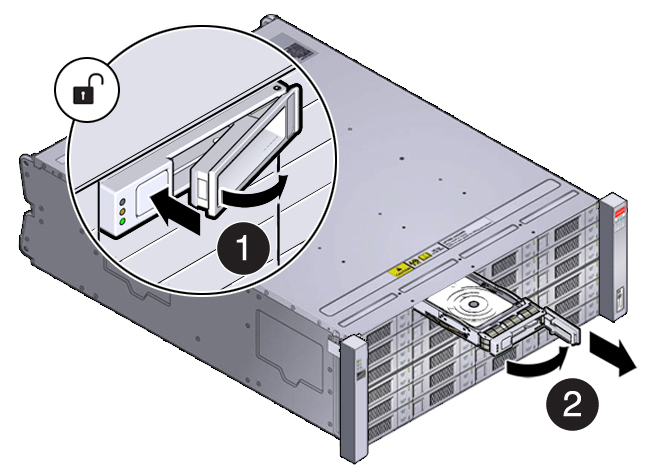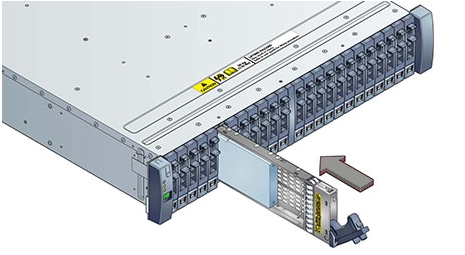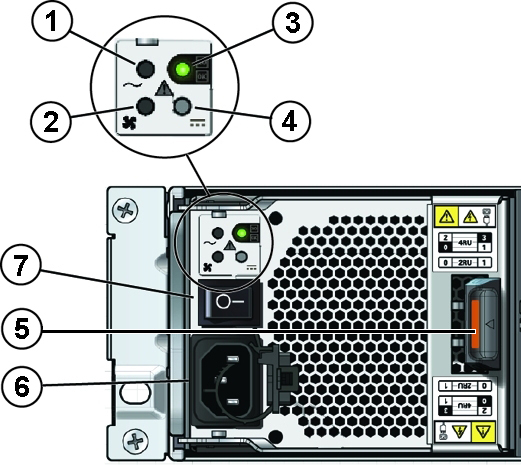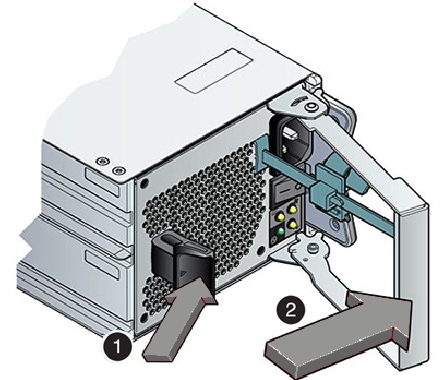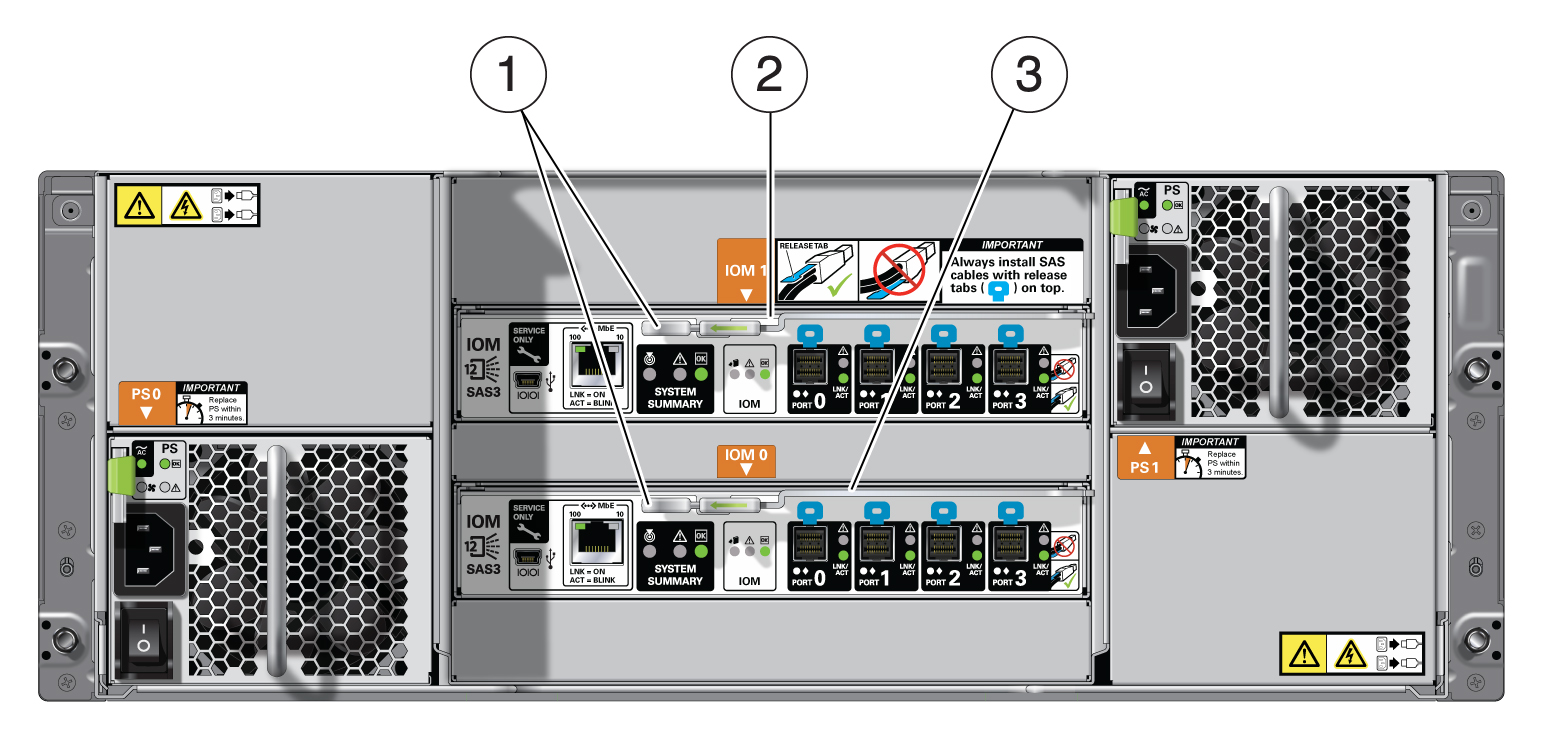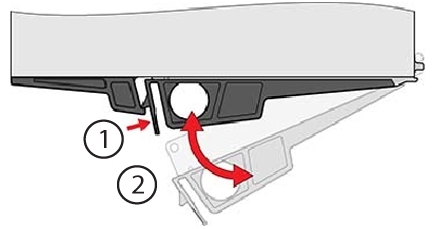3 Servicing CRUs That Do Not Require System Power Off
Perform tasks for servicing hot plug components in the Oracle Database Appliance.
Hot-pluggable components can be replaced with the system powered on.
Note:
Hot-pluggable components can also be replaced with the system powered off. If you choose this method, first power off the system as described in Preparing Oracle Database Appliance for Service.
- Oracle Database Appliance X7-2 Series Server Node Hot-Pluggable Components
This section describes how to perform hot plug tasks on an Oracle Database Appliance X7-2 series server. - Oracle Database Appliance X6-2 Series Server Node Hot-Pluggable Components
This section describes how to perform hot plug tasks on an Oracle Database Appliance X6-2 series server. - Oracle Database Appliance X3-2/X4-2/X5-2 Series Server Node Hot-Pluggable Components
This section describes how to perform hot plug tasks on an Oracle Database Appliance X3-2/X4-2/X5-2 series server. - Oracle Database Appliance X3-2/X4-2/X5-2 and X6-2-HA/X7-2-HA Storage Shelf Hot-Pluggable Components
Perform hot plug tasks on an Oracle Database Appliance storage shelf. - Oracle Database Appliance Version 1 Hot-Pluggable Components
This section describes how to perform hot plug tasks on an Oracle Database Appliance Version 1 system.
Oracle Database Appliance X7-2 Series Server Node Hot-Pluggable Components
This section describes how to perform hot plug tasks on an Oracle Database Appliance X7-2 series server.
If you have Oracle Database Appliance X6-2 series, go to Oracle Database Appliance X6-2 Series Server Node Hot-Pluggable Components. If you have the Oracle Database Appliance X3-2/X4-2/X5-2, go to Oracle Database Appliance X3-2/X4-2/X5-2 Server Node Hot-Pluggable Components. If you have Oracle Database Appliance Version 1, go to Oracle Database Appliance Version 1 Hot-Pluggable Components.
If you are servicing storage shelf hot plug components, see Oracle Database Appliance X3-2/X4-2/X5-2 and X6-2-HA/X7-2-HA Storage Shelf Hot-Pluggable Components.
Hot-pluggable components are those that can be removed and installed while the system is running. These are designated as Customer Replaceable Units (CRUs).
Note:
After a physical insertion or removal action of a storage component (such as a disk or SAS cable), you should wait before performing the next action to allow the system software to fully process the event. This could take up to 3 minutes to complete.
Refer to the following table for hot-plug component instructions for your appliance.
Note:
Some of the links in the following table take you to instructions outside of the Oracle Database Appliance library to the Oracle Server X7-2 documentation library. Use your browser's Back button to return to the Oracle Database Appliance library.
| Oracle Database Appliance X7-2S/X7-2M | Oracle Database Appliance X7-2-HA |
|---|---|
|
Servicing NVMe Storage Drives (CRU) Caution: An NVMe drive must first be powered off before removal. If you do not power off the NVMe drive before removal you can crash the operating system. Oracle Database Appliance uses special commands to remove or add NVMe storage. |
Front mounted storage drives are not supported in the server nodes for this product. |
- Servicing NVMe Storage Drives (CRU)
Perform tasks for servicing NVMe drives in an Oracle Database Appliance X7 series system.
Parent topic: Servicing CRUs That Do Not Require System Power Off
Servicing NVMe Storage Drives (CRU)
Perform tasks for servicing NVMe drives in an Oracle Database Appliance X7 series system.
- Replacing an NVMe Storage Drive
Replace an NVMe drive in an Oracle Database Appliance X7 series system. - Adding NVMe Expansion Storage
Add NVMe storage to an Oracle Database Appliance X7-2M.
Replacing an NVMe Storage Drive
Replace an NVMe drive in an Oracle Database Appliance X7 series system.
Before removing an NVMe drive it must be powered off. After installing an NVMe drive it must be powered on. Failed drives are automatically powered off after 5 minutes.
Caution:
If you remove an NVMe drive without first powering it off, you can crash the operating system. Oracle Database Appliance uses special commands to add or remove NVMe storage.
The instructions describe how to replace an NVMe drive using the odaadmcli power on/off commands for an Oracle Database X7-2 series system.
The odaadmcli commands listed here must be run as the root user.
Parent topic: Servicing NVMe Storage Drives (CRU)
Adding NVMe Expansion Storage
Add NVMe storage to an Oracle Database Appliance X7-2M.
-
The Oracle Database Appliance X7-2M supports six expansion slots for NVMe drives. These are slots labeled 2 through 7 as seen from the front of the system (callouts 1 through 6 in the following illustration). Storage drives can be added in sets of three.
If you have the default configuration of only two NVMe drives (seen as
pd_00andpd_01from the host), you can expand storage by either three (3) or six (6) NVMe drives. -
When expanding storage, populate slots starting with the lowest numbered available slot (for example, slot 2 as seen on the front panel).
-
The drive power-up and storage expansion
odaadmclicommands listed here should only be run after all new disk drives have been physically installed. Once you expand storage, you cannot revert to a previous storage configuration (for example, the default installation with only two NVMe drives). -
The
odaadmclicommands listed here must be run as the root user.
Parent topic: Servicing NVMe Storage Drives (CRU)
Oracle Database Appliance X6-2 Series Server Node Hot-Pluggable Components
This section describes how to perform hot plug tasks on an Oracle Database Appliance X6-2 series server.
If you have Oracle Database Appliance X7-2 series, go to Oracle Database Appliance X7-2 Series Server Node Hot-Pluggable Components. If you have the Oracle Database Appliance X3-2/X4-2/X5-2, go to Oracle Database Appliance X3-2/X4-2/X5-2 Server Node Hot-Pluggable Components. If you have Oracle Database Appliance Version 1, go to Oracle Database Appliance Version 1 Hot-Pluggable Components.
If you are servicing storage shelf hot plug components, see Oracle Database Appliance X3-2/X4-2/X5-2 and X6-2-HA/X7-2-HA Storage Shelf Hot-Pluggable Components.
Hot-pluggable components are those that can be removed and installed while the system is running. These are designated as Customer Replaceable Units (CRUs).
Note:
After a physical insertion or removal action of a storage component (such as a disk or SAS cable), you should wait before performing the next action to allow the system software to fully process the event. This could take up to 3 minutes to complete.
Refer to the following table for hot-plug component instructions for your appliance.
Note:
Some of the links in the following table take you to instructions outside of the Oracle Database Appliance library to the Oracle Server X6-2 and Oracle Server X6-2L (including Storage Server X6-2 Extreme Flash version) documentation libraries. Use your browser's Back button to return to the Oracle Database Appliance library.
| Oracle Database Appliance X6-2S/X6-2M | Oracle Database Appliance X6-2L | Oracle Database Appliance X6-2-HA |
|---|---|---|
|
Servicing NVMe Storage Drives (CRU) Caution: An NVMe drive must first be powered off before removal. If you do not power off the NVMe drive before removal you can crash the operating system. Oracle Database Appliance uses special commands to remove or add NVMe storage. |
Servicing NVMe Storage Drives (CRU) Caution: An NVMe drive must first be powered off before removal. If you do not power off the NVMe drive before removal you can crash the operating system. Oracle Database Appliance uses special commands to remove or add NVMe storage. |
Front mounted storage drives are not supported in the server nodes for this product. |
- Servicing NVMe Storage Drives (CRU)
Perform tasks to service NVMe drives in an Oracle Database Appliance X6 Series system.
Parent topic: Servicing CRUs That Do Not Require System Power Off
Servicing NVMe Storage Drives (CRU)
Perform tasks to service NVMe drives in an Oracle Database Appliance X6 Series system.
This section describes servicing NVMe drives in an Oracle Database Appliance X6-2 series system.
- Replacing an NVMe Storage Drive
Replace an NVMe drive in an Oracle Database Appliance X6 series system. - Adding NVMe Expansion Storage
Add NVMe storage in an Oracle Database Appliance X6 series system.
Replacing an NVMe Storage Drive
Replace an NVMe drive in an Oracle Database Appliance X6 series system.
Before removing an NVMe drive it must be powered off. After installing an NVMe drive it must be powered on. Failed drives are automatically powered off after 5 minutes.
Caution:
If you remove an NVMe drive without first powering it off, you can crash the operating system. Oracle Database Appliance uses special commands to add or remove NVMe storage.
The instructions describe how to replace an NVMe drive using the odaadmcli power on/off commands for an Oracle Database X6-2 series system.
The odaadmcli commands listed here must be run as the root user.
Parent topic: Servicing NVMe Storage Drives (CRU)
Adding NVMe Expansion Storage
Add NVMe storage in an Oracle Database Appliance X6 series system.
-
The Oracle Database Appliance X6-2S/X6-2M supports two expansion slots for NVMe drives. These are slots labeled NVMe2 and NVMe3 as seen from the front of the system (callouts 1 and 2 in the following illustration). When adding NVMe storage, you must populate both of these slots.
If you have the default configuration of only two NVMe drives (seen as
pd_00andpd_01from the host), you can expand storage by adding two (2) NVMe drives. -
The Oracle Database Appliance X6-2L supports three expansion slots for NVMe drives. These are slots labeled NVMe2, NVMe5, and NVMe8 as seen from the front of the system (callouts 1, 2 and 3 in the following illustration). When adding NVMe storage, you must populate all three of these slots.
Note:
Drive slots NVMe9, NVMe10 and NVMe11 are not supported for this product.
If you have the default configuration of NVMe drives (seen as
pd_00,pd_01,pd_03,pd_04,pd_06andpd_07from the host), you can expand storage by adding three (3) NVMe drives. -
The drive power-up and storage expansion
odaadmclicommands listed here should only be run after all new disk drives have been physically installed. Once you expand storage, you cannot revert to a previous storage configuration (for example, the default factory storage configuration). -
The
odaadmclicommands listed here must be run as the root user.
Parent topic: Servicing NVMe Storage Drives (CRU)
Oracle Database Appliance X3-2/X4-2/X5-2 Series Server Node Hot-Pluggable Components
This section describes how to perform hot plug tasks on an Oracle Database Appliance X3-2/X4-2/X5-2 series server.
If you have Oracle Database Appliance X7-2 series, go to Oracle Database Appliance X7-2 Series Server Node Hot-Pluggable Components. If you have Oracle Database Appliance X6-2 series, go to Oracle Database Appliance X6-2 Series Server Node Hot-Pluggable Components. If you have Oracle Database Appliance Version 1, go to Oracle Database Appliance Version 1 Hot-Pluggable Components.
If you are servicing storage shelf hot plug components, see Oracle Database Appliance X3-2/X4-2/X5-2 and X6-2-HA/X7-2-HA Storage Shelf Hot-Pluggable Components.
Hot-pluggable components are those that can be removed and installed while the system is running. These are designated as Customer Replaceable Units (CRUs).
Note:
After a physical insertion or removal action of a storage component (such as a disk or SAS cable), you should wait before performing the next action to allow the system software to fully process the event. This could take up to 3 minutes to complete.
Refer to the following table for hot-plug component instructions for your appliance.
Note:
The links in the following table take you to instructions outside of the Oracle Database Appliance library to the Sun Server X3-2, Sun Server X4-2, and Oracle Server X5-2 documentation libraries. Use your browser's Back button to return to the Oracle Database Appliance library.
| Oracle Database Appliance X3-2 | Oracle Database Appliance X4-2 | Oracle Database Appliance X5-2 |
|---|---|---|
|
Servicing Storage Drives (CRU) Note that for bare metal installations of this appliance, you must run the |
Servicing Storage Drives (CRU) Note that for bare metal installations of this appliance, you must run the |
|
Parent topic: Servicing CRUs That Do Not Require System Power Off
Oracle Database Appliance X3-2/X4-2/X5-2 and X6-2-HA/X7-2-HA Storage Shelf Hot-Pluggable Components
Perform hot plug tasks on an Oracle Database Appliance storage shelf.
This section describes replacing hot-pluggable components for the Oracle Database Appliance storage shelf. Only certain versions of Oracle Database Appliance support a storage shelf. If you have Oracle Database Appliance Version 1, go to Oracle Database Appliance Version 1 Hot-Pluggable Components.
Note:
In certain storage expansion scenarios (explained in the following procedures), adding optional storage might require that the appliance be powered off.
A storage shelf, or expansion storage shelf, are only supported with the following Oracle Database Appliance products:
-
Oracle Database Appliance X7-2-HA supports the DE3-24C shelf.
-
Oracle Database Appliance X6-2-HA supports the DE3-24C shelf.
-
Oracle Database Appliance X5-2 supports the DE2-24C shelf.
-
Oracle Database Appliance X3-2 and Oracle Database Appliance X4-2 support the DE2-24P shelf.
Hot-pluggable components are those that can be removed and installed while the system is running. These are designated as Customer Replaceable Units (CRUs).
Caution:
Data loss. Do not remove power from both power supplies of the storage shelf or storage expansion shelf (if equipped) while any databases are running. If you must power off the storage shelf or expansion storage shelf, stop the database first.
Note:
After a physical insertion or removal action of a storage component (such as a disk or SAS cable), you should wait before performing the next action to allow the system software to fully process the event. This could take up to 3 minutes to complete.
- Servicing Storage Shelf Components
Perform hot plug tasks on an Oracle Database Appliance storage shelf.
Parent topic: Servicing CRUs That Do Not Require System Power Off
Servicing Storage Shelf Components
Perform hot plug tasks on an Oracle Database Appliance storage shelf.
Oracle Database Appliance X7-2-HA (DE3-24C), Oracle Database Appliance X6-2-HA (DE3-24C), Oracle Database Appliance X5-2 (DE2-24C) and Oracle Database Appliance X3-2/X4-2 (DE2-24P) storage shelf components can all be replaced while the storage shelf is powered-on and running. They include:
- Adding Optional Oracle Database Appliance X7-2-HA Storage Shelf Drives (CRU)
Add disk storage in an Oracle Database Appliance X7-2-HA storage shelf. - Adding Optional Oracle Database Appliance X6-2-HA Storage Shelf Drives (CRU)
Add disk storage in an Oracle Database Appliance X6-2-HA storage shelf. - Replace a Storage Shelf HDD or SSD (CRU)
Replace a storage disk in an Oracle Database Appliance storage shelf. - Replace a Storage Shelf Power Supply (CRU)
Replace a power supply in an Oracle Database Appliance storage shelf.
Adding Optional Oracle Database Appliance X7-2-HA Storage Shelf Drives (CRU)
Add disk storage in an Oracle Database Appliance X7-2-HA storage shelf.
-
The Oracle Database Appliance X7-2-HA storage shelf partially-populated base configuration supports 15 expansion slots for either 3.2 TB SSDs (available in five-packs) or 10 TB HDDs (available in a fifteen-pack). These expansion slots are labeled 5-19 as seen from the front of the system (callouts 5 through 19 in the following illustration).
Note the following:
-
Expanding the base configuration storage shelf with 3.2 TB SSDs can be performed with the appliance running. The base configuration has slots 20-23 populated with 800GB drives for REDO and slots 0-4 with 3.2 TB drives for DATA/RECO. Expansion drives are available in five-packs and are populated in shelf storage slots from the bottom up to be used for DATA/RECO, as follows:
- The first five expansion drives go into slots 5-9.
- The second five expansion drives go into slots 10-14.
- The third five expansion drives go into slots 15-19.
The following illustration shows the expanded drive configuration for 3.2 TB SSDs.
When you expand storage, you must first install all of your expansion disks (5, 10 or 15). Once you expand storage to support additional disks, you cannot revert to the base configuration (no drives in slots 5-19).
-
Expanding the base configuration storage shelf with 10 TB HDDs requires that you first power down the appliance. The base configuration has slots 20-23 populated with 800GB drives for REDO and slots 0-4 with 3.2 TB drives for DATA/RECO. Expansion drives are available in a fifteen-pack and are populated in the storage shelf as follows:
- Move the 3.2 TB DATA/RECO drives from shelf storage slots 0-4 to slots 15-19. These will be used for FLASH after redeployment.
- Install the fifteen 10 TB HDD expansion drives into slots 0-14. These will be used for DATA/RECO after redeployment.
The following illustration shows the expanded drive configuration for 10 TB HDDs.
After adding the storage, power on the appliance to perform cleanup, redeploy the appliance and restore the database as described in the Deployment and User's Guide for the appliance. Once you expand storage to support additional disks, you cannot revert to the base configuration (no drives in slots 5-19).
-
-
If you plan on adding another storage shelf, it must be populated identically to your first storage shelf.
-
The
odaadmclicommands listed here must be run as the root user.
Parent topic: Servicing Storage Shelf Components
Adding Optional Oracle Database Appliance X6-2-HA Storage Shelf Drives (CRU)
Add disk storage in an Oracle Database Appliance X6-2-HA storage shelf.
-
The Oracle Database Appliance X6-2-HA storage shelf base configuration (half-populated) supports ten expansion slots for 1.6 TB SSD drives. These are slots labeled 10-19 as seen from the front of the system (callouts 10 through 19 in the following illustration). When adding to the storage shelf, you must populate all of these slots at the same time. This upgrade can be performed with the appliance running.
Note:
If you expand storage, you must first add all of the disks and then expand storage on all the new disks at the same time. Once you expand storage to support disks in slots 10-19, you cannot revert to the base configuration (no drives in slots 10-19).
-
You cannot add a storage expansion shelf to your appliance configuration until you have fully populated the existing storage shelf.
-
The
oakclicommands listed here must be run as the root user.
Parent topic: Servicing Storage Shelf Components
Replace a Storage Shelf HDD or SSD (CRU)
Replace a storage disk in an Oracle Database Appliance storage shelf.
Note:
After a physical insertion or removal action of a storage component (such as a disk or SAS cable), you should wait before performing the next action to allow the system software to fully process the event. This could take several minutes to complete.
Parent topic: Servicing Storage Shelf Components
Replace a Storage Shelf Power Supply (CRU)
Replace a power supply in an Oracle Database Appliance storage shelf.
The storage shelf and the storage expansion shelf each have two power supplies. Indicators (LEDs) on the power supplies indicate their operation state.
The power supplies are redundant and one can be replaced while the appliance is running.
Example figure showing a DE3-24C power supply:
Example figure showing a DE2-24C or DE2-24P power supply:
| Callout | Description |
|---|---|
|
1 |
AC power fail indicator |
|
2 |
Fan fail indicator |
|
3 |
Power supply status indicator |
|
4 |
DC power fail indicator |
|
5 |
Release lever |
|
6 |
AC connector |
|
7 |
On/Off switch |
If any of the indicators are amber, or if the power supply status indicator does not light, replace the power supply.
- Replace a Storage Shelf I/O Module (CRU)
Replace an IO module in an Oracle Database Appliance storage shelf.
Parent topic: Servicing Storage Shelf Components
Replace a Storage Shelf I/O Module (CRU)
Replace an IO module in an Oracle Database Appliance storage shelf.
Storage Shelf SAS I/O modules are fully redundant and can be replaced while the appliance is running.
Note:
After a physical insertion or removal action of a storage component (such as a disk or SAS cable), you should wait before performing the next action to allow the system software to fully process the event. This could take up to 3 minutes to complete.
Parent topic: Replace a Storage Shelf Power Supply (CRU)
Oracle Database Appliance Version 1 Hot-Pluggable Components
This section describes how to perform hot plug tasks on an Oracle Database Appliance Version 1 system.
If you have Oracle Database Appliance X7-2 series, go to Oracle Database Appliance X7-2 Series Server Node Hot-Pluggable Components. If you have Oracle Database Appliance X6-2 series, go to Oracle Database Appliance X6-2 Series Server Node Hot-Pluggable Components. If you have Oracle Database Appliance X3-2/X4-2/X5-2, go to Oracle Database Appliance X3-2/X4-2/X5-2 Hot-Pluggable Components.
Only certain versions of Oracle Database Appliance support a storage shelf (the Oracle Database Appliance Version 1 does not). If you have Oracle Database Appliance that supports a storage shelf and you need to service its components, go to Oracle Database Appliance X3-2/X4-2/X5-2 and X6-2-HA/X7-2-HA Storage Shelf Hot-Pluggable Components.
Hot-pluggable components are those that can be removed and installed while the system and the server nodes are running. These are designated as Customer Replaceable Units (CRUs).
In Oracle Database Appliance Version 1, the following devices are hot-pluggable:
-
Storage and Boot Drives. See Servicing Storage Drives and Boot Drives (CRU).
-
Fan modules. See Servicing Fan Modules (CRU)
-
Power supplies. See Servicing Power Supplies (CRU)
Parent topic: Servicing CRUs That Do Not Require System Power Off
